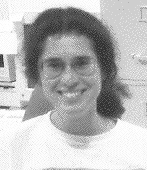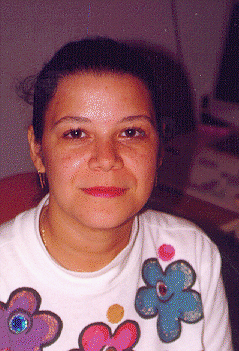
Susan Nossal. Photo by Brett Isham.
Susan began working at the Observatory in October 1994 as an NSF/CEDAR postdoctoral research associate. She also spent a part of her two-year contract at NCAR in Boulder, Colorado. Her research focused on how measurements of exospheric hydrogen could most effectively be used with the NCAR global atmospheric models to further our understanding of upper atmospheric variability and model boundary conditions. Susan also studied the various factors that could result in apparent temporal changes in the exospheric hydrogen emissions observed with a Fabry-Perot interferometer. This is an important topic since the quantity of exospheric hydrogen is believed to be a sensitive indicator of global change induced by the anthropogenic increase in methane production. The Observatory continues to make this measurement, and her work should help us to interpret any observed trends. Furthermore, to improve the accuracy of the calculated coupling between the lower and upper atmospheric hydrogenous species, Susan proposed modifications to the chemical model.

Susan Nossal. Photo by Brett Isham.
In September Susan left for the University of Wisconsin in Madison, where she holds a postdoctoral position shared between the Physics and Atmospheric and Oceanic Sciences Departments. She is working on two projects: (1) To design and coordinate the exospheric observational program for the Wisconsin H-alpha mapper, a remotely operable Fabry-Perot instrument, and (2) to model the distribution and transport of chemical constituents in the lower and middle atmosphere.
While in Arecibo, Susan worked hard at learning Spanish and was actively involved in local community organizations. No doubt she will continue her community service activities wherever she may be. The Observatory and the neighborhood will miss her. We wish her the best of luck in all her future endeavors.
On November 1, Peter Hofner joined the Arecibo staff as a post-doctoral research associate. A German citizen, Peter comes to us from the Institute of Physics, University of Köln, where he has been working with the 3-m KOSMA sub-millimeter telescope on the Gornergrat in Switzerland. He obtained his Diplom in Physics from the University of Tübingen in 1988, with a research thesis titled "General Relativistic Effects in Rotating Neutron Stars," then moving to the University of Madison-Wisconsin for his M.S. and Ph.D. He obtained the latter in 1995 on the subject of "Hot Molecular Cores Associated with Ultra-Compact HII Regions," working on this with Ed Churchwell. Peter has an extensive list of publications, and is a familiar face at molecular-line conferences. He is also a veteran of observations with many telescopes, spanning the spectrum from radio to x ray.

Peter Hofner. Photo by Tony Acevedo.
Peter comes to Puerto Rico accompanied by his wife, Berta, and their young son, Hans. They have all fitted straight in to life here as Berta hails from Costa Rica, while Peter is also fluent in Spanish. Meanwhile, Hans is improving the standard of German spoken by the NAIC staff! We welcome the Hofners on board, and wish them the happiest of stays at Arecibo.
On the 9th of October, Mayleen Serrano became a permanent member of the Observatory purchasing staff. Born on the island, she moved to Pennsylvania with her parents and worked many years with the Internal Revenue Service before returning. College graduate and fully bilingual, she will work as Purchasing Aide to the Pappas pavilion.
Some of you may recall that the Electronics Department was in some disarray after the departure of our long-time secretary Aida Pérez for medical reasons. Order and efficiency returned on July 12 when Nirza Torres began working as the new department secretary.

Nirza Torres. Photo by Tony Acevedo.
Arecibo staff members already know Nirza as a pleasant and efficient co-worker. She returned to Puerto Rico this year after spending thirty years in Chicago. The Observatory is her first employment "back on the island" although she is pure Puerto Rican having been born in Juana Díaz.
In Chicago, Nirza worked for Arthur Andersen, the world's largest accounting firm. She was very involved as the volunteer chairperson for the United Way within the company, as well as being responsible for client satisfaction. For her dedication to community concerns in Chicago, she was honored by the Chicago Urban Council as well as the group Chicago Cares.
Nirza has been married ten-and-a-half years after meeting her husband-to-be on a blind dinner date. Their daughter, Yadira, is "the love of my life," notes Nirza with happiness. Sometimes on school holidays Yadira can be seen in the lab counting hundreds of mica capacitors. All the members of the Observatory staff extend a hearty welcome and congratulations to Nirza.
The Acting Director of the Beijing Astronomical Observatory, Rendong Nan, and two of his fellow astronomers, Yuhai Qiu and Xiang Xu, visited Arecibo for a week. Their objective was to gain first-hand insight into spherical-reflector radio telescopes as they plan the "30-Arecibo" synthesis telescope in south-central China.

From left to right: Yuhai Qiu, Xiang Xu, Rendong Nan, and
Mike Davis. Photo by Tony Acevedo.
The spherical reflector was not one of the prime candidates in 1993 when URSI set up the Large Telescope Working Group with the objective of realizing a square kilometer of collecting area at meter wavelengths. However, after various meetings of astronomers from ten observatories around the world, an array of thirty Arecibo-style telescopes has become one of the configurations under serious consideration. But this option requires thirty suitable sink holes as well! As it turns out, the south-central Chinese province of Guizhou has a very high density of karstic depressions, where our visitors have located three areas with a total of about 700 sink holes! Site surveys, measurements of the RFI environment, and design studies are under way. They are attempting to increase the declination and zenith angle coverage over a substantial part of the sky. When asked about funding, our visitors seemed hopeful that the project will receive a large amount of funding from the Chinese government. However, since it will be an international facility for the next millennium, they expect other participating countries to extend their support as well.
Copyright 1996, Cornell University
Return to Arecibo Observatory home page.
Generated with Harlequin WebMaker